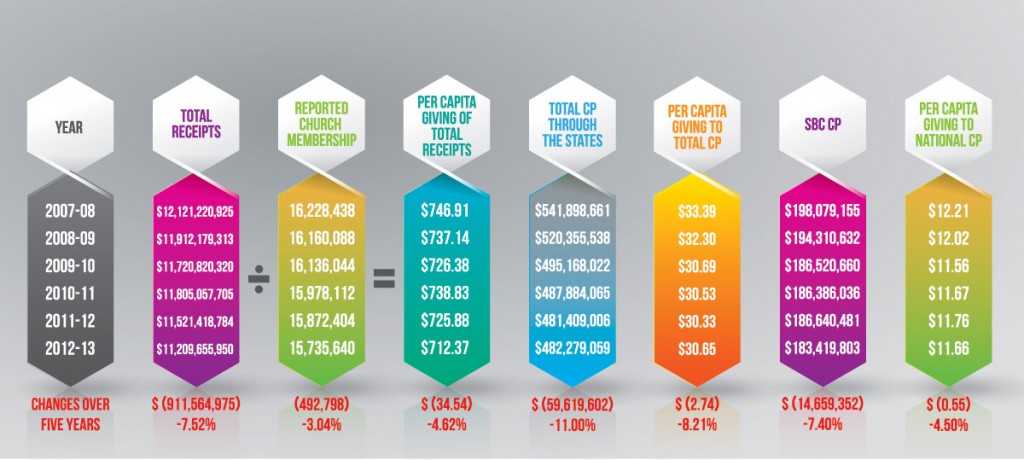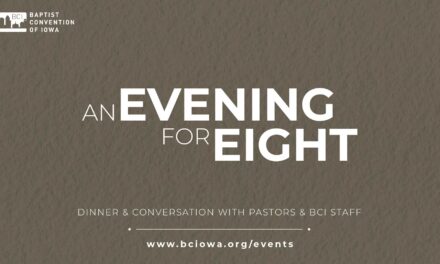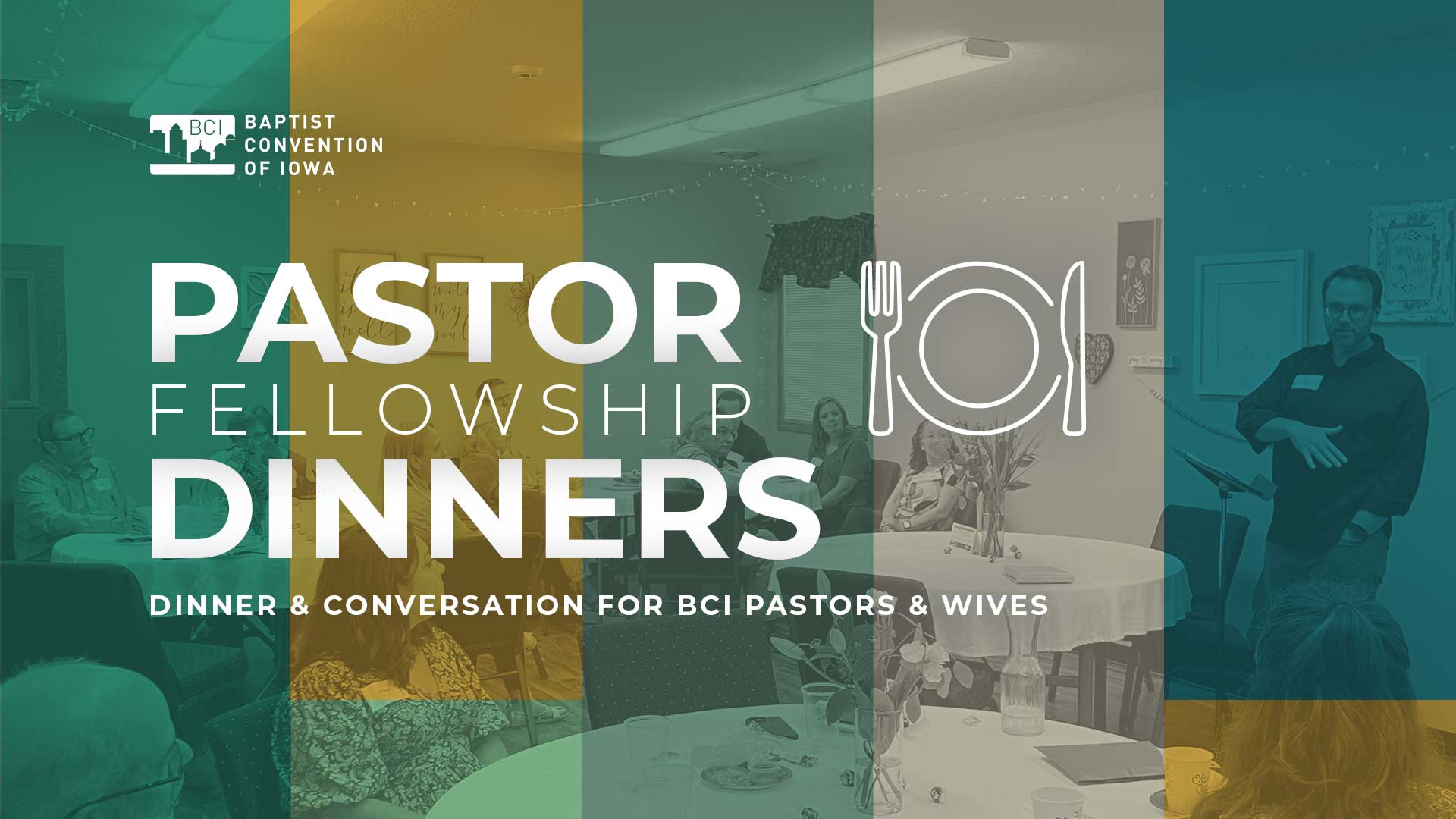by Sing Oldham
NASHVILLE (BP) — Despite a five-year decline in church membership and a corresponding decrease in per capita giving, the national portion of the Cooperative Program shows signs of rebounding through the first five months of fiscal 2014–2015.
Year-to-date contributions to the Southern Baptist Convention Cooperative Program Allocation Budget through Jan. 31 totaled $64,702,035.77, the highest amount since the Jan. 31, 2012, report. Though lower than the $67.8 million received through January 2010, the $65.6 million in 2011, and the $65.1 million in 2012, this marks the first increase through the first four months of the fiscal year since 2012 and may be a harbinger that local churches are recovering from the lingering effects of the Great Recession.
As of Feb. 28, receipts totaled $82,098,104.34, or 104.81 percent of the $78,333,333.33 year-to-date budgeted amount to support SBC ministries globally and nationally. The total is $2,371,418.56 more than the $79,726,685.78 received through February 2014.
The two SBC seasonal missions offerings — Lottie Moon Christmas Offering for International Missions (LMCO) and Annie Armstrong Easter Offering for North American Missions (AAEO) — have also shown positive signs of rebound. After plummeting from $150 million in 2007 to $141 million in 2008, offerings to the LMCO slowly edged upward through 2012 before reaching and surpassing 2007’s previous high in 2013, topping $154 million for a new record, though still short of the $175 million goal.
Similarly, gifts to the AAEO declined from its record $59 million in 2007 before beginning to recover in 2011 and reaching $58 million in 2014, the third highest amount in history.
While monthly CP Allocation Budget reports often show significant swings based on the number of Sundays in a given month, the day of the month churches forward their CP contributions to their state conventions, and the timing of when state conventions forward the national portion of their CP contributions to the Executive Committee, this increase through five months, coupled with strengthening support for LMCO and AAEO, show signs that the long-term impact of the global economic crisis may be past.
Five years of local church decline
This positive report stands against the stark reality that giving to Southern Baptist churches for all causes — general budget gifts, missions offerings, missions trips, and other church ministry needs –declined by more than $911 million from 2008 to 2013, a decline of 7.52 percent, according to the Annual Church Profile submitted by cooperating Southern Baptist churches.
Total membership declined by 3.04 percent during the same period of time, from 16,228,438 to 15,735,640, a decline of almost one-half million people (492,748).
Per capita giving also declined over the same period, from $746.91 per member in 2008 to $712.37 in 2013. The combination of declining membership and declining per capita giving impacted the ability of local churches to do ministry in their communities and beyond and has been felt by both state Baptist conventions and the SBC (see accompanying chart).
For example, even though churches increased the percentage of their undesignated receipts forwarded through the Cooperative Program from 5.407 percent in 2011 to 5.414 percent in 2012 and to 5.50 percent in 2013, the actual dollar amount of CP continued to decline, hovering at a 14-year low the past two years.
The Cooperative Program model
The Cooperative Program was established in 1925 as a collaborative effort between the SBC and state Baptist conventions to assist churches. Prior to that time, ministry leaders from scores of state and national ministries routinely asked churches for time in their worship services to promote their ministries and to receive designated offerings from the church members.
The churches being asked to fund the ministries of the SBC were, by and large, the same churches being asked to support the ministries of individual state Baptist conventions. Inundated with so many requests from so many legitimate ministries, pastors and churches alike grew weary.
Recognizing the drain these requests made on the churches, pastors and convention leaders hammered out a plan that sought to address the problem of so many special offerings. The plan was remarkably simple:
1. individuals give their tithes and offerings to their local churches;
2. the churches would forward a percentage of their contributions to their state Baptist convention for ministry in the state;
3. the state convention would then forward a percentage of its funds to provide support for SBC missions and ministries.
Through a unified, cooperative program of giving, both sets of ministries could be funded — state ministry needs and ministry endeavors of the SBC. In 1925, this cooperative venture between churches, state conventions, and the SBC was given the name Cooperative Program.
The “50/50 ideal” CP division
When the Cooperative Program was formed, a 50/50 division between the state conventions and the SBC (after shared ministry costs associated with promoting CP were deducted) was lifted up as an ideal goal. This target has been reemphasized at SBC annual meetings several times over the years, most recently in 2010 with the adoption of the Great Commission Task Force report.
The actual division, however, has never reached that suggested ideal.
During the CP’s first five years, the division languished at the 80/20 rate (or lower) — 80 percent remaining in the state, 20 percent forwarded to SBC causes. The division finally surpassed 70/30 in the opening years of the 1930s before falling back to a more or less steady 74/26 rate during the remainder of the Great Depression.
During the World War II years and, indeed, for the majority of the CP’s ninety-year history, the division forwarded by the states to the SBC fluctuated between 33 percent and 37 percent per year, with three notable exceptions.
During the post-World War II growth spurt in Southern Baptist church attendance and baptisms (1946–1952), the division of CP funds forwarded by the state conventions to SBC causes exceeded 38 percent for the first time, reaching an all-time high of 40.5 percent in 1951.
During the first decade of the SBC’s Bold Mission Thrust initiative, which corresponded with the height of the SBC Conservative Resurgence, both of which began in 1979, the division of CP funds forwarded by the state conventions again reached and exceeded 38 percent (1985–1991), reaching a high of 39.1 percent in 1988.
The third era in which the percentage of CP gifts from the churches forwarded by the state conventions to the SBC exceeded 38 percent is in the current post-Great Commission Resurgence time frame (2011–2013), reaching 38.8 percent in 2012 before falling back slightly last year. Figures for 2014 will be released later this spring.
State conventions take strides
Each of the first two periods when the CP percentage forwarded by the states to SBC causes exceeded 38 percent came at times of unprecedented economic prosperity, denominational optimism, and corresponding growth in church membership. The current era stands in marked contrast.
As noted above, the current economic realities faced by cooperating churches have been challenging. The amount of CP funds contributed by churches to the state Baptist conventions has fallen from a high of $542 million in 2008 to last year’s $482 million, a decline of 11 percent, putting significant strain on state convention budgets.
Despite the drastic drop in CP gifts to the state conventions, the states have increased the amount they forward to the SBC from 36.55 percent in 2008 to more than 38 percent each of the past three budget years. In order to meet these demanding goals, states began streamlining ministries and reducing staff by hundreds of ministry specialists and support staff (from 1,750 to 1,350 in 33 state conventions that responded to an Executive Committee survey in 2013).
State conventions continued forward progress in sacrificial giving during their fall 2014 annual meetings. Messengers in Iowa and Nevada increased support for SBC causes by adopting 50/50 percentage splits between their respective state conventions and the SBC with no shared ministry deductions. The Baptist Convention of Iowa moved from 20 to 50 percent, while the Nevada Baptist Convention voted to raise its percentage of CP gifts to SBC causes from 35 to 50 percent.
These two joined the Southern Baptists of Texas Convention, which has forwarded 50 percent or more of its CP gifts to SBC causes since its founding, as the only three that have met the ideal suggested in 1925 — without deducting shared ministry items.
Five state conventions increased the percentage they forward to SBC causes by more than 1 percent while messengers to an additional 15 state conventions voted to increase the SBC portion in amounts ranging from 0.02 to 1 percent.
The Southern Baptist Conservatives of Virginia is in the process of phasing out its shared ministries category with a goal of forwarding 51 percent for SBC missions and ministries.
Churches, CP, and why they give
Churches continue to believe in the ministry objectives their messengers have assigned to the Convention’s entities. Cooperating churches forwarded, on average, 5.5 percent of their undesignated receipts through CP in the most recent year of record (2013). While the increase is modest, the 5.5 percent figure marks the second year of growth in average gifts through CP, reversing more than 20 years of decline.
This growth parallels the findings of a 2012 CP survey that asked pastors about the “1% CP Challenge” issued by Executive Committee President Frank S. Page in 2011. More than 7 percent of pastors reported their churches had accepted the “1% CP Challenge,” increasing their CP contributions by 1 percent or more of the church’s undesignated receipts in their churches’ 2012 annual budget. A 2014 CP survey found that an additional 3,500 churches reported a similar commitment for their 2014 budgets.
At the national level, messengers to the SBC have assigned a specific set of ministry responsibilities to each SBC entity. These ministry assignments are listed in the Convention’s Organization Manual and published in each year’s SBC Book of Reports and SBC Annual and are posted online at www.sbc.net/aboutus/legal/organizationmanual.asp.
The following highlights come from the 2014 SBC Book of Reports:
— IMB reported supporting more than 4,800 fully-funded overseas missionaries who, in conjunction with their work with national partners, reported nearly 6,200 new churches and more than 114,000 baptisms.
— NAMB reported more than 2,600 fully-funded, jointly-funded, and student missionaries, 3,514 endorsed chaplains, 169 church planting catalysts, and 936 new churches planted.
— The seminary presidents reported 15,993 Southern Baptist students among its 18,259 non-duplicating head count enrolled for ministerial training through the Convention’s six seminaries.
— ERLC actively engaged hundreds of pastors, churches, elected officials, and the courts and had more than 1,200 “strategic media contacts” on numerous issues of biblical ethics, public policy, and religious liberty.









